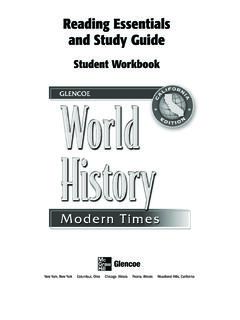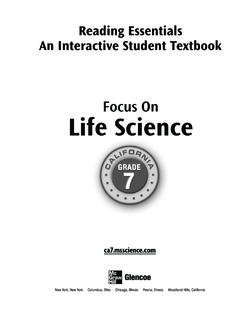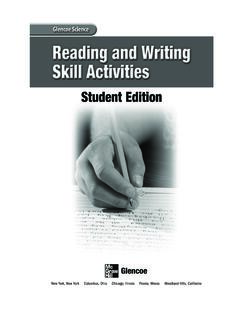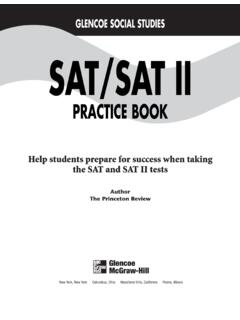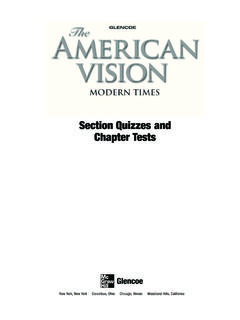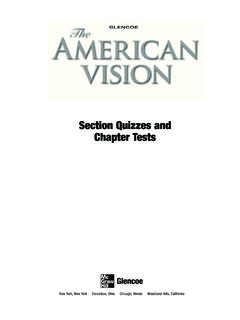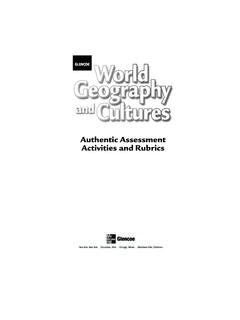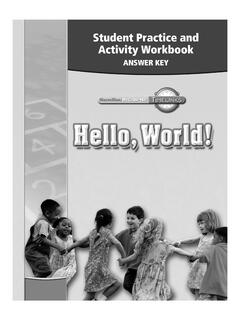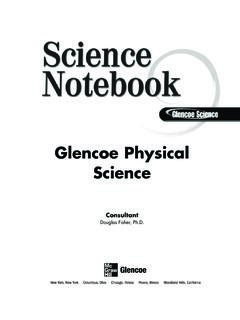Transcription of Study Guide for Content Mastery - Student Edition
1 Study Guide forContent MasteryStudent EditionHands-On Learning:Laboratory Manual, SE/TEForensics Laboratory Manual, SE/TECBL Laboratory Manual, SE/TESmall-Scale Laboratory Manual, SE/TEChemLab and MiniLab WorksheetsReview/Reinforcement: Study Guide for Content Mastery , SE/TESolving Problems: A Chemistry HandbookReviewing ChemistryGuided Reading Audio ProgramApplications and Enrichment:Challenge ProblemsSupplemental ProblemsAssessment:Chapter AssessmentMindJogger Videoquizzes (VHS/DVD)Computer Test Bank, Windows/MacIntoshTeacher Resources:Lesson Plans Block Scheduling Lesson PlansSpanish ResourcesSection Focus Transparencies and MastersMath Skills Transparencies and MastersTeaching Transparencies and MastersSolutions ManualTechnology:Chemistry Interactive CD-ROMV ocabulary PuzzleMaker Software, Windows/MacIntoshGlencoe Science Web site: by The McGraw-Hill Companies, rights reserved. Permission is granted to reproduce the material contained hereinon the condition that such material be reproduced only for classroom use; be providedto students, teachers, and families without charge; and be used solely in conjunctionwith the Chemistry: Matter and Changeprogram.
2 Any other reproduction, for use orsale, is prohibited without prior written permission of the all inquiries to:Glencoe/McGraw-Hill8787 Orion PlaceColumbus, OH 43240-4027 ISBN 0-07-824522-2 Printed in the United States of 3 4 5 6 7 8 9 10 045 09 08 07 06 05 04 03 02A Glencoe ProgramCopyright Glencoe/McGraw-Hill, a division of the McGraw-Hill Companies, Guide for Content MasteryChemistry: Matter and ChangeiiiTo the Student ..ivStudy Skills ..vChapter 1 Introduction to Chemistry ..1 Chapter 2 Data Analysis ..7 Chapter 3 Matter Properties and Changes ..13 Chapter 4 The Structure of the Atom ..19 Chapter 5 Electrons in Atoms ..25 Chapter 6 The Periodic Table and Periodic Law ..31 Chapter 7 The Elements ..37 Chapter 8 Ionic Compounds ..43 Chapter 9 Covalent Bonding ..49 Chapter 10 Chemical Reactions ..55 Chapter 11 The Mole ..61 Chapter 12 Stoichiometry ..67 Chapter 13 States of Matter ..73 Chapter 14 Gases ..79 Chapter 15 Solutions.
3 85 Chapter 16 Energy and Chemical Change ..91 Chapter 17 Reaction Rates ..97 Chapter 18 Chemical Equilibrium ..103 Chapter 19 Acids and Bases ..109 Chapter 20 Redox Reactions ..115 Chapter 21 Electrochemistry ..121 Chapter 22 Hydrocarbons ..127 Chapter 23 Substituted Hydrocarbons and Their Reactions ..133 Chapter 24 The Chemistry of Life ..139 Chapter 25 Nuclear Chemistry ..145 Chapter 26 Chemistry in the Environment ..151 Study Guide FOR Content MASTERYC ontentsCopyright Glencoe/McGraw-Hill, a division of the McGraw-Hill Companies, : Matter and ChangeStudy Guide for Content MasteryThis Study Guide for Content MasteryforChemistry: Matter and Changewill help you learn more easily from your textbook. Each textbook chapterhas six Study Guide pages of questions and exercises for you to complete asyou read the text. The Study Guide pages are divided into sections that matchthose in your text. You will find that the directions in the Study Guide for Content Masteryare simply stated and easy to follow.
4 Sometimes you will be asked to answerquestions. Other times, you will be asked to interpret a diagram or completea table. By completing the Study Guide , you will gain a better understandingof the concepts presented in the text. These sheets also will prove helpfulwhen studying for a you begin your work, read the Study Skills section at the front ofthis booklet. The Study Skills section will help you improve your reading skills. improve your vocabulary skills. learn from visuals. make and understand idea skills will help ensure your success in studying chemistry and anyother the StudentCREDITSArt CreditsNavta Associates:ix, 25, 35, 39, 71, 80, 85, 97, 114, 135;Glencoe:x, xi, 4, 10, 12, 24, 34, 53, 74,75, 78, 98, 121, 125, 132, 154, 155, 156; MacArt Design:14, 48, 63, 92, 139, 143, 149 Copyright Glencoe/McGraw-Hill, a division of the McGraw-Hill Companies, Guide for Content MasteryChemistry: Matter and ChangevA. Improve Your Reading SkillsActive readers are good readers.
5 Active readers get ready before they read. use skills that help them when they read. review to remember after they s what you can do to become an active reader!Before You ReadGet Ready to Read Find a quiet time and place to read library, Study hall, home. Don t read when you re tired. Don t read when you re hungry. Wait until you have finished a section before you take a Quickly scan the material so you will know what it is about. Look at pictures and read the captions, titles, headings, and words in Write notes about what you see when you scan. Write questions about what you see. Write topics you want to find out about when you read. Write a preview outline from the section You Read Find the main idea of each section or paragraph this is usually in thefirst sentence. Study the pictures, maps, graphs, and tables, and think about the information in them. Write down the main ideas and other notes about what you read. After you read the whole section, reread the parts you didn t Guide FOR Content MASTERYS tudy SkillsCopyright Glencoe/McGraw-Hill, a division of the McGraw-Hill Companies, : Matter and ChangeStudy Guide for Content MasteryAfter You Read Review your outline or the notes you wrote while youwere reading.
6 If you still have questions, ask a classmate or your teacherfor help. Write important facts or ideas on flash cards. Review your flash cards to help you remember whatyou ve Improve Your Vocabulary SkillsActive readers learn the meanings of new words. Active readers recognize clues to help find the meaning. look for familiar words and word parts in new words. use a dictionary often. practice new words so they can remember new s how you can improve your vocabulary!When You See a New WordScan Read the sentence and look for clues about the meaningof the word. These are called context clues. Look for pictures or visuals that contain the the following table, you can find different kinds of contextclues that you can use to help you figure out the meanings ofnew Guide FOR Content MASTERYS tudy SkillsCopyright Glencoe/McGraw-Hill, a division of the McGraw-Hill Companies, Guide for Content MasteryChemistry: Matter and ChangeviiSTUDY Guide FOR Content MASTERYS tudy SkillsSearch for Context CluesComparison andcontrastDefinition anddescriptionSynonymsTone and settingA series of cluesCause and effectThe runner started the race with energyand excitement, but as she crossed thefinish line, the fatigueand strain showedon her is a chemist, a scientist who studies matter and the changes that is very dependable.
7 His teachers andhis parents know that he is reliable and canbe air of jubilationsurrounded the members of the science team as theyreceived their medals for first place in thenational elements helium, oxygen, andnitrogen are all Student group was known for itsboisterousmeetings, so the principal askedextra teachers to monitor the meeting andkeep sentence contrasts theword fatiguewith energy andcompares it to strain. This tellsyou that someone who isfatigued is strained and has sentence describes a chemistas someone who studies matter and the changesthat it word dependableisdescribed by the synonymsreliable and setting of the sentence and the action describe a situation that is positive andfull of elements that are mentioned are all gases. Thistells you something about theword the meetings and tells you thatsomething needs extra Glencoe/McGraw-Hill, a division of the McGraw-Hill Companies, : Matter and ChangeStudy Guide for Content MasteryBreak It Down Find the root word.
8 Write it and ask questions about its meaning. Find the affix the part in front of or after the root word. Write it down and use a dictionary to look up its this table, you can see how to break words into their roots and New Words Say the word aloud. Write another sentence using the word. Make flash cards that include the word and its meaning. Review your flash cards to help you remember the meanings of the new Guide FOR Content MASTERYS tudy SkillsWordRootAffix and MeaningMeaningimperfectperfectim- (not)not perfectsemicirclecirclesemi- (half)half of a circleteacherteach-er (one who)one who teachesbackwardback-ward (in the direction of)to the backpublicizepublic-ize (make)make publicCopyright Glencoe/McGraw-Hill, a division of the McGraw-Hill Companies, Guide for Content MasteryChemistry: Matter and ChangeixC. Learn From VisualsTables, graphs, photographs, diagrams, and maps are called visuals. Goodreaders use all kinds of visuals to help them learn.
9 Active readers find the purpose for the visual they see. find information in the visual. connect the information they find to what they are s how you can improve your skill in learning from You First Look at a VisualScan Look at the visual. Decide its purpose. Why is it there? Find the title. Read the Write the purpose of the visual. Why is it there? Write the key information. Write the title of the visual. Write the main idea or Guide FOR Content MASTERYS tudy Skills1000 100 20023 PeriodBoiling Point PeriodicityBoiling point ( C)45 Copyright Glencoe/McGraw-Hill, a division of the McGraw-Hill Companies, : Matter and ChangeStudy Guide for Content MasteryAs You Study the VisualGraphsGraphs are pictures of related information. A graph tells you something abouta specific situation. There are many kinds of graphs. One of the most commonis the bar graph. A bar graph helps you compare similar information about different items. Theseparate items being measured are shown as rectangles side by side on diagram is a drawing that has labels on it.
10 It can show how somethingworks or what the parts are called. A diagram often gives the names of the parts of something, like this diagramof an electromagnetic wave. Science books often have many Wavelength AmplitudeGrade 9 Grade 10 Grade LevelNumber of studentsGrade 1112040206080100 Number of Students in Each GradeSTUDY Guide FOR Content MASTERYS tudy SkillsCopyright Glencoe/McGraw-Hill, a division of the McGraw-Hill Companies, Guide for Content MasteryChemistry: Matter and ChangexiTablesTables organize words and numbers for easier reading. They have a title,columns (up and down), and rows (side to side). In this table, the columnsshow the innings, and the rows show the points each team give all kinds of different information. Some examples are location,direction, and land features. They can have words, symbols, numbers, lines,and Fields of the United StatesFigure is the most abundant fossil fuel on Earth. The coal deposits of the United States are mainly bituminous coal, which is preferred for electric power generation.
